Yves GARY Hits: 3714
Category: 1901 : CHALLENGE N°11
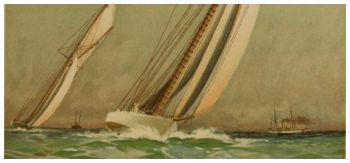 COLUMBIA WINS A DECISIVE VICTORY
COLUMBIA WINS A DECISIVE VICTORY Oct. 4, 1901 - The second race for the America's Cup was sailed yesterday, over a triangular course off Sandy Hook and Columbia won by ...
Oct. 4, 1901 - The second race for the America's Cup was sailed yesterday, over a triangular course off Sandy Hook and Columbia won by ...
... 2 minutes and 52 seconds actual time. She beat Shamrock II on each of the three legs of the course and fairly outsailed her at every point. She proved herself a wonderful yacht and justified the action of the Challenge Committee of the New York Yacht Club in selecting her to defend the famous trophy of the yachting world. The race was a perfectly satisfactory test of the comparative merits of the contesting vessels. It was sailed in ideal conditions.
 THE RACE IN DETAIL
THE RACE IN DETAILThe two racers left their anchorage inside the Hook at 9 o'clock sharp, and proceeded to the Sandy Hook Lightship under tow. The Regatta Committee's boat Navigator arrived on time, and at 10:30 took her position about 300 yards north by east of the lightship. The wind at this time was freshening. It had been fair up in the harbor, and had lightened under the lee of the land in the lower bay. At the time when the committee boat anchored it was by no means a stiff breeze, but was quite good enough to insure a finish for the race. In other words, it was blowing at the rate of about eight knots an hour. The sea was beautiful to look at, and in perfect condition for an exhibition of speed between two racing machines.
 About the same time as the committee boat anchored she displayed the international code letter D, which meant that the race was to be over a triangular course or thirty miles, ten miles to each leg. The two yachts had made sail on the way out, and now cast off their tugs. Both were under mainsails, clubtopsails, jibs, and forestaysails, and presently they sent their jib topsails up in stops. At 10:35 the committee boat hoisted the usual three sets of-signals, showing what were the courses for the day. The hoists read D C F, east, one-half south; D F M, southwest, one-half south, and D G S, north northwest. The third leg was to be the windward leg, and if the wind held true, as it did, this would be dead to windward and nothing off. The first and second legs were set so as to be broad reaches.
About the same time as the committee boat anchored she displayed the international code letter D, which meant that the race was to be over a triangular course or thirty miles, ten miles to each leg. The two yachts had made sail on the way out, and now cast off their tugs. Both were under mainsails, clubtopsails, jibs, and forestaysails, and presently they sent their jib topsails up in stops. At 10:35 the committee boat hoisted the usual three sets of-signals, showing what were the courses for the day. The hoists read D C F, east, one-half south; D F M, southwest, one-half south, and D G S, north northwest. The third leg was to be the windward leg, and if the wind held true, as it did, this would be dead to windward and nothing off. The first and second legs were set so as to be broad reaches.
The preparatory signal was given at 10:45. The exact conditions at this time were wind north northwest, freshening to a speed of ten knots; sea smooth; tide at the top of the flood. High water was reached at 11 o’clock, and the yachts had the tail of e stream against them as they went off on the first leg.  There was no favor for either in this, however. The tide outside the Hook is not an important element in a race, except in working along either of the shores. Near the lightship one yacht gets about the same treatment from it as another.
There was no favor for either in this, however. The tide outside the Hook is not an important element in a race, except in working along either of the shores. Near the lightship one yacht gets about the same treatment from it as another.
When the preparatory signal was set, both yachts were on the weather of the committee boat. Shamrock luffed up into the wind and hung there, while Columbia, running off, passed to leeward of her. It was now a question of what tactics the skippers would adopt. There was to be no exciting jockeying for the start, for it was not to be a tight tor the weather berth. The racers were to go away with the wind a little abaft their beams on a reach, and most expert racing skippers, having to sail the allowing boat would have chosen to send the other boat away first with the allowance as a present. The business of the allowing boat would then be simply to overhaul the other. The only question yesterday was whether Capt. Sycamore would do this or go first and take the chance of having Columbia out into his weather, blanket, and pass him on the very first leg.![Columbia and Shamrock II before the start - [1901] Oct. 3](/images/stories/1901/Oct03-03.jpg) It proved that he was not afraid to take the latter course, and this argued well for his confidence in the ability of Shamrock to outfoot Columbia.
It proved that he was not afraid to take the latter course, and this argued well for his confidence in the ability of Shamrock to outfoot Columbia.
Between the preparatory and warning guns the two yachts occupied themselves with running of with sheets flat and hauling up or tacking, always circling about in the neighborhood of the committee boat, Columbia keeping to windward. When the warning gun was tired both were just to leeward of the lightship, which was at the southerly end of the line. They now stood across the front of the line, Shamrock holding the leeward course, but ahead of Columbia. At the windward end of the line Shamrock bore away, and Columbia followed in her wake. Shamrock luffed up and went on the starboard tack. Columbia did the same under her opponent’s lee. Both were now heading back toward the line outside of the Navigator. Columbia bore away first and passed around the Navigator’s bow ahead of Shamrock.
 GAVE SHAMROCK THE LEAD.
GAVE SHAMROCK THE LEAD.Shamrock now jibed, and, breaking out her jib topsail, a size larger than the one known as a baby, rushed across the line with her boom to starboard and her headsails swelling round and taut as if they would burst. Instead of crossing the line after his opponent, Capt. Barr pushed Columbia way up to windward and then tacked. And now, having let Shamrock get a lead of over a minute and a half, Columbia raced across the line, breaking out her jib topsail, which was longer on the luff than that carried by Shamrock, as she started on her journey. The race was new on, and the excursion fleet opened throttles wide, for the speed of the racers promised to leave them all far in the rear.
Shamrock crossed the line at 11:00:13 and Columbia at 11:01:47. All that Capt. Barr had now to do was to catch Shamrock and hold her and he would have a victory of 2 minutes and 30 seconds.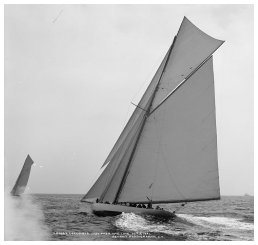 As it proved in the end this was a very pretty piece of calculation. The actual victory was 2 minutes and 52 seconds, and the addition and the time allowance made it 3 minutes and 35 seconds. Columbia did more than her sailing master asked of her. As soon as the yachts were fairly on their course it was seen that Shamrock stood up better than Columbia. But this was only temporary. The wind was coming off the land in heavy puffs, and first one yacht would lie down and then the other.
As it proved in the end this was a very pretty piece of calculation. The actual victory was 2 minutes and 52 seconds, and the addition and the time allowance made it 3 minutes and 35 seconds. Columbia did more than her sailing master asked of her. As soon as the yachts were fairly on their course it was seen that Shamrock stood up better than Columbia. But this was only temporary. The wind was coming off the land in heavy puffs, and first one yacht would lie down and then the other.
Columbia's steering was interesting in the first half of the first leg. As each heavy puff struck her she acted like a catboat and shot up into the wind in spite of the helm. But of course this was a matter which could easily be remedied. When Capt. Barr decided that the American yacht had eaten as far up into the wind as it was healthy for her to go, he slacked away his mainsheet a bit and eased her. After that she steered much better. Shamrock steered to perfection from the start. Her mainsail was flat, but it seemed to have no bad effect on her, and she did not run up into the wind nearly as much as Columbia.
Away out ahead of Columbia was her tender, the steamboat Park City, and it was plain that the defender of the cup was following her and not the Buccaneer. It must be remembered that the New York Yacht Club has eliminated the element of navigation from these cup contests. 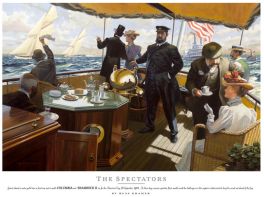 Skippers do not have to hunt for marks now, but are provided with a guide boat which steam along the course a couple of miles ahead of the racers and shows them the way. But Columbia in addition to this has had her own private guide boat in the Park City, and yesterday, on the first leg of the course, at any rate, she followed this boat and not the official guide boat. The services of the latter were utilized by Shamrock.
Skippers do not have to hunt for marks now, but are provided with a guide boat which steam along the course a couple of miles ahead of the racers and shows them the way. But Columbia in addition to this has had her own private guide boat in the Park City, and yesterday, on the first leg of the course, at any rate, she followed this boat and not the official guide boat. The services of the latter were utilized by Shamrock.
It was 11:25 when Columbia eased her mainsheet, or when the yachts were just half way to the first mark. As they drew near to the mark Columbia bore away a little, and Shamrock eased her mainsheet. To round the mark it was necessary for both yachts to gybe. Shamrock rushed down on the mark which loomed clear and sharp against the bright blue sky, and she made as pretty a gybe as any sailorman could wish to see. Columbia was plainly close upon her heels, and she too went around the mark in the most skillful manner.
The skippers were not taking any chances of carrying away anything, and mainsheets were gathered in and turns caught around cleats as the booms went over. Shamrock rounded the mark at 11:51:10 and Columbia at 11:52:22 o'clock.
This showed that the American yacht had gained 22 seconds on the first leg of the course, and the hearts of her friends were accordingly encouraged. As Shamrock rounded in the lead the whistles of the excursion steamers were pulled wide open, and hoarse shrieks of congratulation swept across the field of dancing waters.
As soon as the Yachts had entered upon the second leg of the course Columbia slacked her jibtopsail sheet, but made no change in her sails. The challenger held everything as it was, for the wind was about the same on this leg as on the first, except that it was on the other side of the yachts. In rounding the mark Shamrock having the leeward berth, was brought closer to it, and consequently shot further past it in jibing before she could be brought on the new course. Columbia, on the other hand, being to windward had her helm hard up, and was in the act of jibing over as she passed the mark, and thus she rounded up into the weather berth on the second leg.
Sycamore kept Shamrock straight away on her course, but Barr sought for a higher position by luffing Columbia still further out to the windward of Shamrock's wake. The force of the wind had been increasing, and it now was about fifteen knots an hour, while the puffs were even speedier. The yachts lay down till their lee rails were in the sea, and the water was streaming along the decks. But so steady was the ocean under them that they rolled not the least bit, while their bows barely nodded to the light surface chop. But every slap of the wind waves under their bows sent clouds of smoke like spray across their decks, while they hurled acres of foam from under their advancing prows. Up to windward the little waves were standing up lean and sharp, and occasionally the wind cut off their slender tops, and sent them spinning to leeward in sheets of snowy spoondrift. Shamrock had to slack her jibtopsail sheet several times in the puffs to take the tremendous strain off her long pole mast, but Columbia, after the first easing of this sheet, let it stand.
 As they neared the second mark the wind was at the top of its force, and neither yacht could carry the jibtopsail quite to the turn. At 12:42 Shamrock took hers in, and half a minute later Barr seemed glad enough to follow suit. As the yachts neared the mark Columbia eased off to leeward so as to make a turn close to the mark. Shamrock rounded first at 12:45:57, Columbia following at 12:46:39. This showed that the defender had gained 30 seconds on the second leg. Any gain at all made victory hers unless Shamrock could overcome it on the windward leg. To have made victory doubtful Columbia must have lost 43 seconds, the amount of her time allowance, in the first two legs. With a gain to her credit, she now looked a sure winner.
As they neared the second mark the wind was at the top of its force, and neither yacht could carry the jibtopsail quite to the turn. At 12:42 Shamrock took hers in, and half a minute later Barr seemed glad enough to follow suit. As the yachts neared the mark Columbia eased off to leeward so as to make a turn close to the mark. Shamrock rounded first at 12:45:57, Columbia following at 12:46:39. This showed that the defender had gained 30 seconds on the second leg. Any gain at all made victory hers unless Shamrock could overcome it on the windward leg. To have made victory doubtful Columbia must have lost 43 seconds, the amount of her time allowance, in the first two legs. With a gain to her credit, she now looked a sure winner.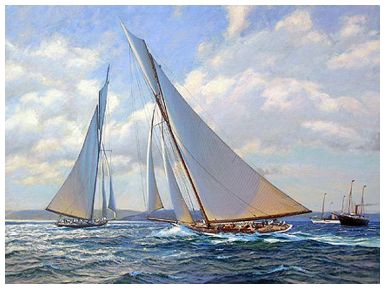
Rounding the mark, Shamrock hauled up on the starboard tack and headed off toward the New Jersey Shore, but Columbia, on rounding the mark, at once went about and stood out to sea on the port tack. Shamrock, therefore, immediately went about and followed her example. This placed Shamrock on Columbia’s weather, about 300 yards to windward. And now began the last struggle, in which Columbia showed her greatest superiority over her rival. It did not require more than five minutes of observation to show that Columbia was footing faster than Shamrock. There were a few moments after Columbia had run abreast of Shamrock and under her lee when the challenger held her own and even seemed to go the faster of the two, but this was not a lasting condition. Shamrock pulled herself out ahead, and Columbia at 1:06 went on the starboard tack. Shamrock tacked almost at the same instant on Columbia’s lee bow. On the new board Shamrock held the leeward berth, but was ahead. A minute after the tack Columbia caught a fine puff, which sent her up 50 yards or so, and now she began to hunt Shamrock in deadly earnest. Both yachts were lying down to their work in magnificent style, but Columbia's speed was the greater.
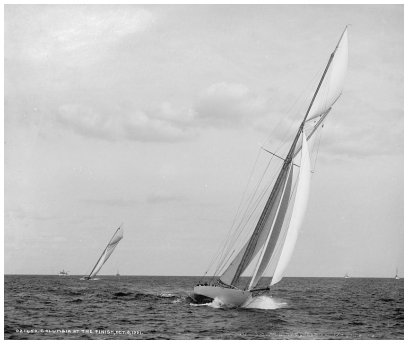 At 1:10 it was seen from the press tug, which was lying directly abeam of the racers to leeward, that Columbia's bowsprit overlapped the boom of Shamrock. The defender, now made a tremendous burst of speed,. and at 1:12 walked right through Shamrocks lee, and in a few moments clear water showed between the end of her boom and the point of Shamrock's bowsprit. At 1:16 Columbia was fully 300 yards ahead, though still to leeward. Two minutes later Barr began to squeeze the defender to work her out across Shamrocks bows. He was too far to leeward to accomplish this, but nevertheless he gained something.
At 1:10 it was seen from the press tug, which was lying directly abeam of the racers to leeward, that Columbia's bowsprit overlapped the boom of Shamrock. The defender, now made a tremendous burst of speed,. and at 1:12 walked right through Shamrocks lee, and in a few moments clear water showed between the end of her boom and the point of Shamrock's bowsprit. At 1:16 Columbia was fully 300 yards ahead, though still to leeward. Two minutes later Barr began to squeeze the defender to work her out across Shamrocks bows. He was too far to leeward to accomplish this, but nevertheless he gained something.
Evidently Capt. Sycamore was afraid that Columbia would work out far enough to cross Shamrocks bows, for at 1:20:35 the challenger was thrown to the port tack. Fifteen seconds later Columbia went on the same tack, and now it was plain that she was to windward. In a few minutes she had the challenger a quarter of a mile dead under her lee, and there the gold boat stayed. 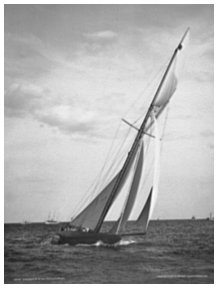 The race was over, and Columbia could not lose unless she carried away her topmast.
The race was over, and Columbia could not lose unless she carried away her topmast.
This port tack proved to be a very long board for both. They held on till they were away to the northward of Seabright, which lay on the western rim of the sea picture some twelve miles away. It looked as if they were both bound for some Long Island port, but finally at 1:57:10 Shamrock led the way to the starboard tack, and Columbia followed in five seconds. It was plain now that both had over stood, and as they headed for the lightship they took the wind not more than two and a half points forward of the beam. But the significant fact was that when Shamrock tacked she was directly astern of Columbia as the latter came about, and the defender had a lead of a quarter of a mile on the same tack.
From this tack to the end it was a procession, with the defender in the van. Both luffed a little to windward of their course, but eased off as they neared the mark. Columbia approached the line at railroad speed, and rushed across it at 2:15:05, a glorious winner, amid the cheers of the spectators and the wild shrieks of a hundred whistles. Shamrock followed 1 minute and 18 seconds later, a thoroughly beaten boat.
| SUMMARY OF THE RACE |  |
On the first leg of the course Columbia took 50 minutes and 35 seconds, while Shamrock required 50 minutes and 57 seconds. Columbia's gain 2 seconds.
On the second leg Columbia took 54 minutes and 17 seconds, and Shamrock 54 minutes and 47 seconds. Columbia’s gain 30 seconds.
On the last and windward leg Columbia‘s elapsed time was 1 hour 28 minutes 26 seconds, and Shamrock's 1 hour 30 minutes 26 seconds. Columbia's gain, 2 minutes.
Over the entire course Columbia beat Shamrock 2 minutes and 52 seconds. By corrected time Columbia won by 3 minutes and 35seconds.</>
